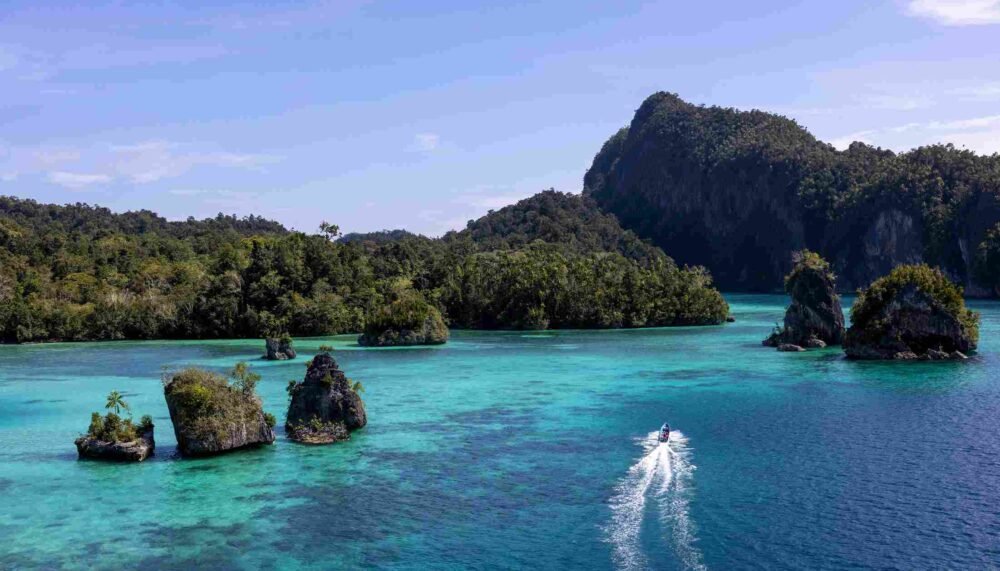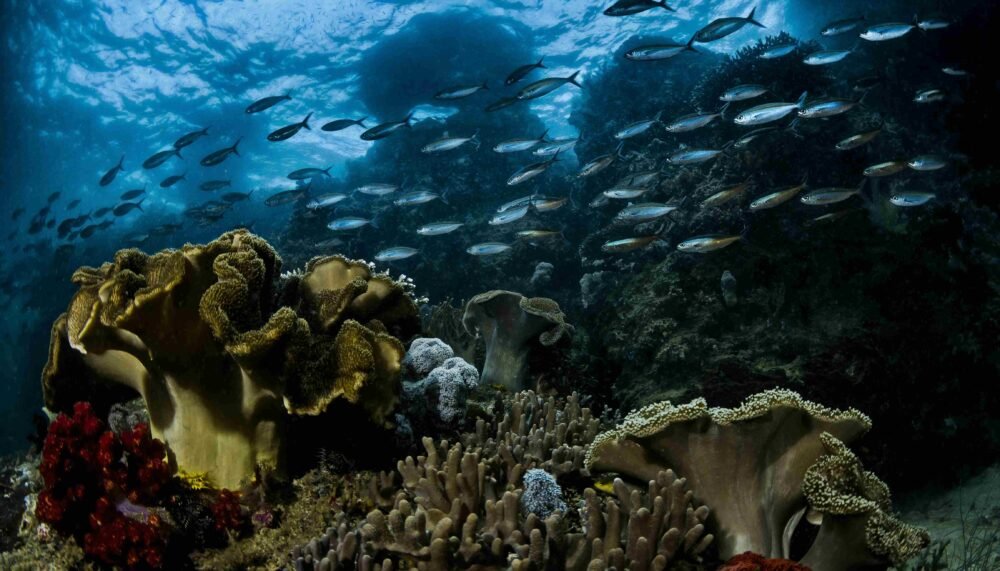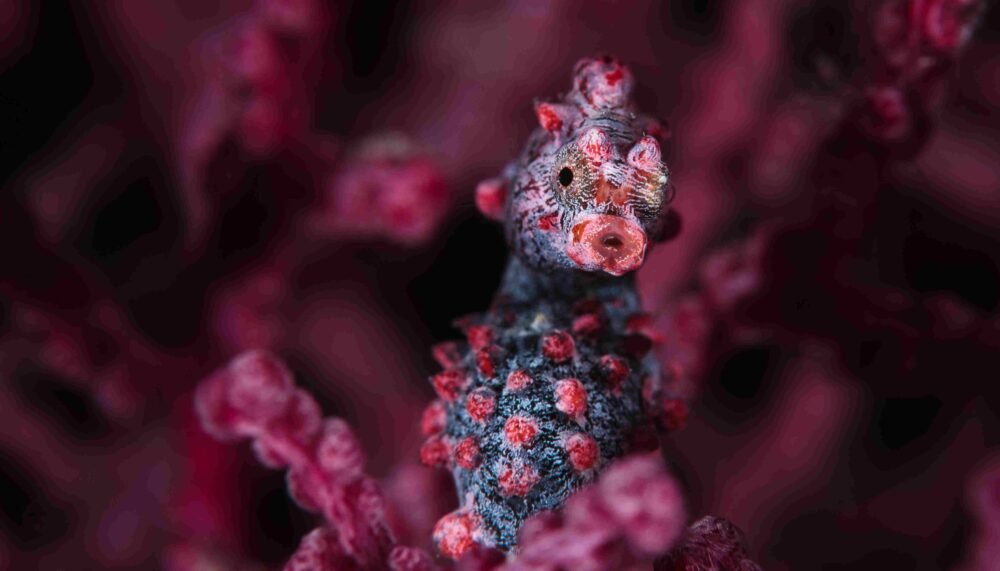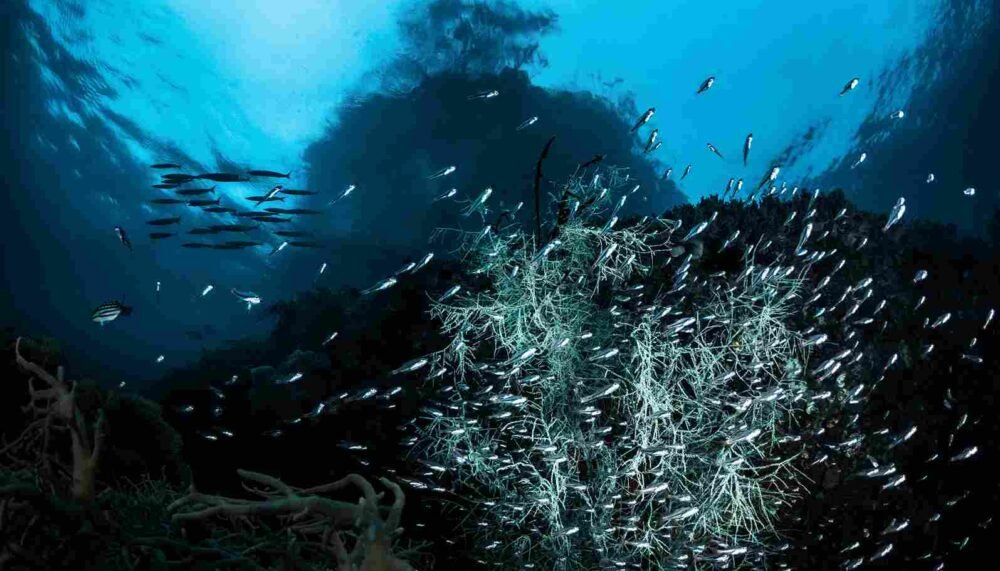Word: Ayu Arman
Nearly all marine creatures throughout the Indonesian region can be found here. Pygmy sharks roam freely among coral gardens and greenish limestone peaks beneath the waters of Triton Bay.

As we entered Ermun Beach, the entrance to Triton Bay, our eyes were immediately captivated by the enchanting panorama emanating from the expanse of white sand with turquoise waters. Because of its crystal-clear clarity, from the sea surface our eyes could directly witness coral reefs, turtles, and fish swimming. While above, we observed clusters of steep karst hills crowned with lush tropical vegetation and perfect small islands.
Triton Bay is one of three areas in West Papua known as the Bird’s Head Seascape. It is the center of world marine biodiversity.
Its natural expanse presents a long story of how nature formed a harmonious relationship between animals and plants; between rocks, minerals, fossils, soil, and water, long before humans conjoined creating colony in it.

Several geological studies delve into important information about the islands in the West Papua region; about an ancient geological ecosystem formed by the movement of the Pacific plate and the formation of deep-sea during the Jurassic Period. Approximately 125 million years ago, or the Late Cretaceous Period, the Australian Continent moved northward and formed an island arc. (Supriatna, 1995)[1]
It is geologically estimated that the India-Australia Plate moved about 8 cm per year to the northeast, and the Pacific Plate moved about 10 cm per year to the northwest, forming the Sorong fault which divided, among others, Waigeo Island, Misool, Kofiau, Mansuar, Triton Bay, and its surroundings.
The movement of these two plates formed straits which are a combination of tropical island karst landscapes and stunning coral reefs. Along the southern part of the bird’s neck area stretching from southwest to southeast, including Triton Bay, Arguni Bay, we can find beautiful rock formations.
Various karst rocks in Triton Bay and its surroundings are composed of 24 rock formations estimated to be 150 to 240 million years old. Through tectonic processes, these ancient rocks formed island clusters. The rock formations include alluvium, uplifted coral reefs, conglomerates, mushroom rocks, and coal formations. There are also Pariri diorite, tectonic mixtures, Klasafet formations, Lengguru limestone formations, Waripi formations, Imskin limestone, Ekmal sandstone, Piniya mudstone, and Woniwogi rocks. Additionally, there are Kopai formations, Tipuma formations, Aiduna formations, Kwatisore granite, paleozoic rocks, and mesozoic rocks.

These rich formations become the underwater habitat for astonishing species of fish. The first underwater diving survey in Triton Bay was conducted in 2006 by a team from Conservation International, the University of Papua, and mostly by liveaboards. The results of the survey then prompted the Kaimana government to declare an area of 6,000 square kilometers around Kaimana and Triton Bay waters as a Marine Protected Area in 2008.
Marine biologists note that Triton Bay is part of the Coral Triangle Center which has more fish and coral species than elsewhere on the planet.
Research conducted by Allen and Erdmann (2009)[2] explains that the waters of Kaimana are inhabited by 605 species of zooxanthellae corals, representing 66% of the total species in the world; and 471 species of coral with the diversity of species reaching half of the world’s corals, namely 58.95%.
For the diversity of coral fish species, in Triton Bay, there are over a thousand species, accounting for 24.95% of the total coral fish species in the Indo-Pacific region (4,100 species). In short, the coral empire of Triton Bay becomes the home to green turtles, coastal Bryde’s whales, whale sharks, dolphins, and blind cave fish. It also becomes the spawning ground of groupers. In summary, almost all marine creatures found throughout Indonesia can be found in the waters of Triton Bay.
To date, the biodiversity of Kaimana waters continues to surprise divers as new creatures are discovered while diving. Therefore, some divers nickname this bay as the home of the sea god Triton. In Greek mythology, Triton is the god of the sea and the messenger in the ocean. Triton is depicted as a half-man, half-fish creature. His body has the color of seawater and he has seashells on his shoulders. In the name of the god Triton, we can say that this is the ultimate diving paradise in the world.
Here, in Triton Bay, you will find all kinds of marine creatures, from the smallest ones, schools of fish with various shapes, colors, and sizes, dolphins, oceanic manta rays, marlins, to huge whale sharks roaming around fishermen’s nets. Even more amazing, when shallow hard and soft coral reefs bloom, various colors and lights appear. It is truly beautiful. You can see large rocks wrapped in colorful corals, bushes of large black coral, and greenish limestone peaks.

That is the underwater forest of Triton Bay. Coral reefs and their ecosystems are essentially like tropical rainforests on the seabed. Not only do they delight the eyes during diving but also provide a source of life. In Triton, you don’t need to dive deep, for example, 20 meters, to get a stunning visual. By just 10 meters diving, the colors of the safari world appear before your eyes. Real. Not artificial.
Currently, most diving locations are around Iris Strait, Aiduma Island, Dramai Island, and southeastern part of Triton Bay. There are 30 top diving spots identified by Triton Bay Divers, the first dive resort in Kaimana. Of course, there are still many more dive sites to be explored.
Among these 30 diving spots, there are some that you should not miss:
Saruenus Island. Also known as Pintu Arus, this small island offers a world-class diving experience. The most famous dive sites on this island are Komodo Kecil, Pintu Arus, and Akuarium. These three locations feature stunning views of diverse soft corals.
Komodo Kecil is the best diving site. The name Komodo Kecil was coined by Larry Smith, a diver who pioneered diving in the Triton Bay area before his passing in 2007 in Sorong. At depths ranging from 5 to 25 meters, you will find dense and extensive bushes of black coral with brightly colored soft corals, covered with glassfish, and providing shelter for barramundi fish, small schools of sweetlips, snappers, and wobbegong sharks.
You can also find a variety of different species of pygmy seahorses as well as nudibranchs and shrimps. During calm current, you can dive along the beautiful soft coral-covered walls and witness the spectacle of thousands of fish of the same size swimming together coordinately in groups or colonies.

Akuarium is a small diving site, but it offers beautiful displays of soft coral reefs and an incredible abundance of fish schools. The best time to dive at this site is in the morning when the water is calm.
Pintu Arus. Here, you will witness a carpet-like soft coral garden that is truly breathtaking! You can also dive with giant groupers and thousands of playful fish. However, be cautious because Pintu Arus sometimes has strong currents. If even fish can’t swim against the current, you definitely can’t. When the current flows, large schools of fish such as blue-striped snappers and lens fish arrive, and the coral becomes spectacular as they feed in the moving water.
Dramai Island, located at the bottom of Iris Strait, is one of the stunning world-class diving locations. Swimming down the slope and circling the north quadrant of this island, you will encounter large rocks covered with giant soft corals along the slope to a depth of 25 meters.
The beautiful soft coral reef serves as the backdrop for an attraction of diverse colony of fish species, including pinjalo snappers, mask surgeonfish, sweetlips, napoleon wrasses, fusiliers, giant trevally, bluefin trevally, rare groupers, and barracuda.
Watch the pinjalo snappers as they swarm around the coral; they resemble bees. Sometimes their bodies display a dark red color that quickly changes to bright pink and even fine silver as they pass through different coral areas. Thus, diving at this location will make you feel small amidst the swirling schools of fish in fairly massive groups with colorful lights.
Flasher Beach. It is Located in the northwestern part of Aiduma. This island is named after the flasher wrasse, a coral fish with striking color diversity.
Pelangi Bo. This location is close to Komodo Kecil. It features large rocks covered with soft corals and schools of fish. Ten to fifteen species of Spanish mackerel live here along with macro creatures such as purple variety of skeleton shrimps, nudibranchs, and pygmy seahorses. Here, you will find nearly all species of pygmy seahorses, muricella gorgonian sea fans, and hippocampus denise in various colors of red, white, pink, and yellow. There is even a cave for swimming with a height of about 1—5 meters.
Batu Putih dan Batu Makro. These locations feature coral bushes and gentle sloping reefs reaching a depth of about 14 meters. This is where macro creatures, wobbegong sharks and frogfish, reside. Batu Makro is mostly white sand bottom expanding about 20 meters and is great for subjects like nudibranchs, especially early in the season when the water temperature is cooler.
Poin Andy. This diving site is always full of surprises. Every time we dive, we see something new, from yellowfin barracudas, schools of bumphead parrotfish, large schools of baitfish being hunted, cruising devil rays, wobbegong sharks, solar-powered nudibranchs, to pygmy seahorses. The most striking feature is the black coral, which is more spectacular than elsewhere in Triton Bay.

Batu Jatuh. It is named Batu Jatuh after the large rocks that tumble into the sea. This location boasts an extensive hard coral garden that every photographer dreams of. Here, you will also find a large school of batfish along with hunting jacks, midnight snappers, bumphead parrotfish, napoleon wrasse, mobula rays, eagle rays, and even strange mantas.

